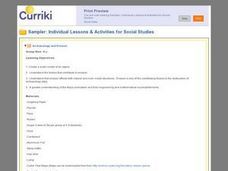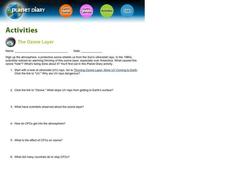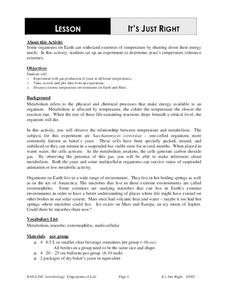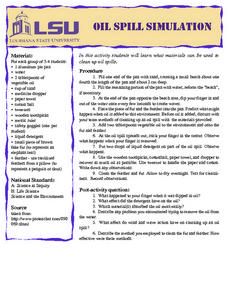Curated OER
Whale Blubber
Students examine the purpose and characteristics of whale blubber. They work together to complete an experiment to test the fat as an insulator. They discover how humans use materials to protect them from the cold.
Curated OER
Food Webs
Students produce a newspaper covering topics related to food webs. They use print and electronic sources to gather information about specific animals. They share their information with the class.
Curated OER
World in the Balance
Students explore population growth. They calculate how long it takes a country's population to double in size and to investigate factors affecting growth rate. In addition, they list of factors they think might affect growth rate
Curated OER
Australian Mammals: Evolutionary Development as a Result of Geographic Isolation
Learners comprehend the difference between monotremes, marsupials, and placental mammals. They are able to compare and contrast these organisms (Australian mammals) with other mammals. Students are able to identify Australian mammals.
Curated OER
Weather and Climate
Young scholars explore all the facets about weather and analyze how weather and climate are connected through time. They consider how weather changes and the effects of weather on the present state of the Earth's climate. Alterations to...
Curated OER
Seeing the Seafloor Using Sound - Multibeam Sidescan Sonar
Students are told that sound is not just stuff that our ears hear. They are explained that it is a tool for measuring and looking at objects in a new way. Students are introduced to sound waves and sonar imaging. They are explained...
Curated OER
Adaptations of Fishes for Survival in Polar Environments
Learners compare the anatomy of temperature and polar fishes. They explore the adverse effects of cold on metabolism and physiology and discuss how polar fishes adapt to their environments. Comparisons are also made to the DNA sequences...
Curated OER
Migrate, Adapt, or Hibernate
In this migration and hibernation worksheet, students read a 2 page informational excerpt about animals who adapt to changing seasons by migrating or hibernating. They then use the information they learned to answer the 15 questions on...
Curated OER
Archaeology and Erosion
Sixth graders study how erosion affects archaeology sites. In this investigative instructional activity, 6th graders construct a model of a pyramid using sugar cubes. They will investigate in groups how water, wind, and sunlight affects...
Curated OER
Continental Drift Lab-Wegener's Evidence
In this continental drift worksheet, 7th graders answer 7 questions about Wegener's theory of continental drift. They use a diagram of the Earth's continents that show plate tectonics.
Curated OER
Kelvin Temperatures and Very Cold Things!
In this Kelvin temperature scale worksheet, students solve 6 problems using the equations for the conversion of Centigrade to Fahrenheit and Kelvin to Centigrade. They convert between Fahrenheit and Kelvins and Centigrade and Kelvins.
Curated OER
I love penguins!
Learners listen to stories and view video about penguins. In this penguins lesson plan, students research penguins in groups and present a report using their choice of technology or artwork presentation.
Curated OER
Feature Column: Virtual Field Trips
Students discover ways to stay healthy by utilizing Internet education software. In this computer technology lesson, students investigate Internet programs that simulate a field trip by showing images and video. Students...
Curated OER
The Ozone Layer
In this ozone activity students complete an interactive activity on the thinning of the ozone then answer a series of questions on the earths UV rays.
Curated OER
It's Just Right
Students conduct an experiment to determine the temperature tolerance of yeasts. In this biology lesson, students collect data and compare them by plotting graphs. They explain how extreme temperatures affect organisms.
Curated OER
Searching for Meteorites
Students examine meteorites and attempt to recover meteorite fragments. In this space lesson students complete a demonstration on the impact of a meteorite using water balloons and make experimental predictions.
Curated OER
Where's King Solomon when we need him?: Good decisions on resources
High schoolers use geographic information to suggest how to manage natural resources through a simulation. They engage in a simulation, and decide how to protect, allocate, and exploit the resources of a hypothetical location.
Curated OER
Oil Spill Simulation
Students examine the materials that can be used to clean up an oil spill. They experiment with vegetable oil and a variety of substances to see which clean the oil the best.
Curated OER
Penguin With Primary Lines
In this penguin paper worksheet students see a detailed drawing of a penguin. Inside the body are widely spaced primary lines for students to write on.
Curated OER
Under the Ice: Imaging Glacier Bases with Sound
Students investigate with radio waves that are used to remotely sense the topography beneath the ice sheet. They experiment with travel time of waves and convert data to distance and depth. As a result, they develop a profile of the...
Curated OER
Bees
In this reading comprehension worksheet, students read the passage titled Bees. They then answer the 10 questions pertaining to the passage.
Curated OER
Food Webs
Young scholars research what food is eaten by the following organisms: penguins leopard seals, krill, elephant seals, petrels, albatross, fur seals, squid, insects and grass. They make a food web using the data they have gathered.
Curated OER
Some Like It Hot, Some Like It Cold
Students are explained that thermophiles are organisms that have optimal growth temperatures above 50oC. They investigate the temperature ranges for the growth of common bacteria. Students answer the question of do either of these...
Curated OER
Art-seal Glyph
In this directed drawing seal glyph worksheet, students follow directions to draw a seal. Detailed , multi-step directions are given. Students draw features according to specific preferences.

























